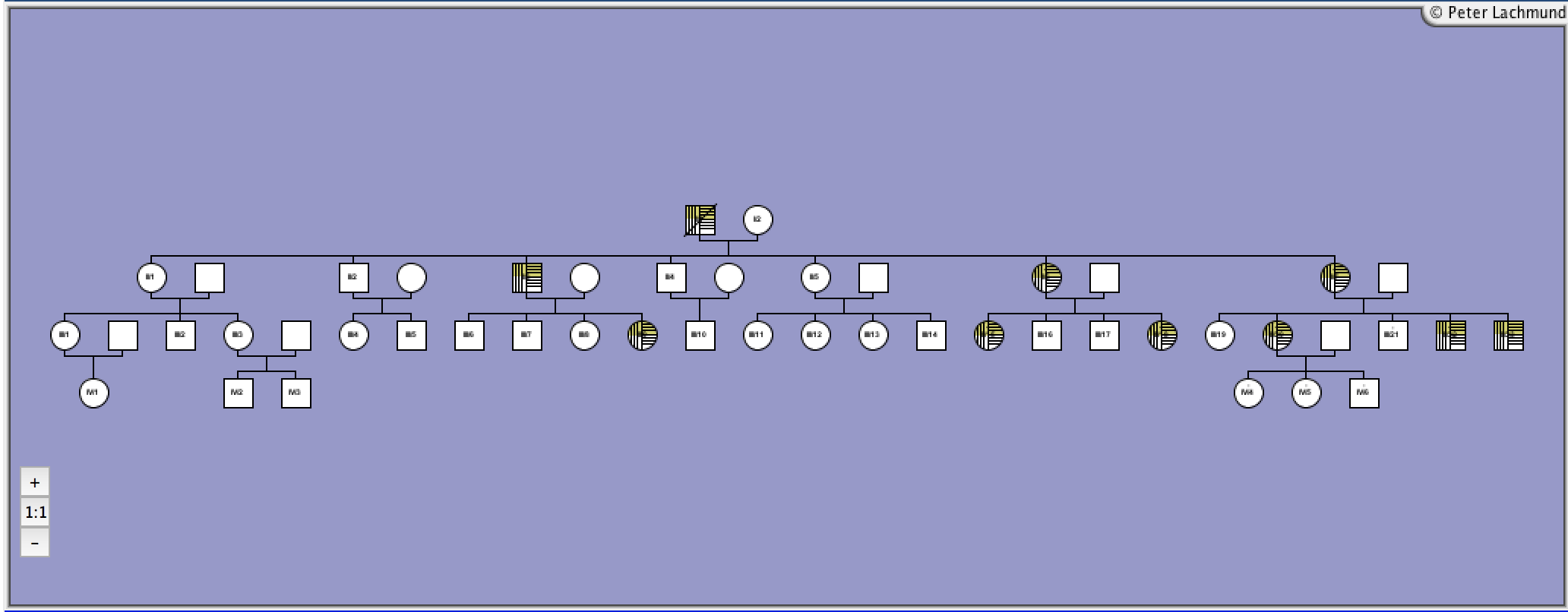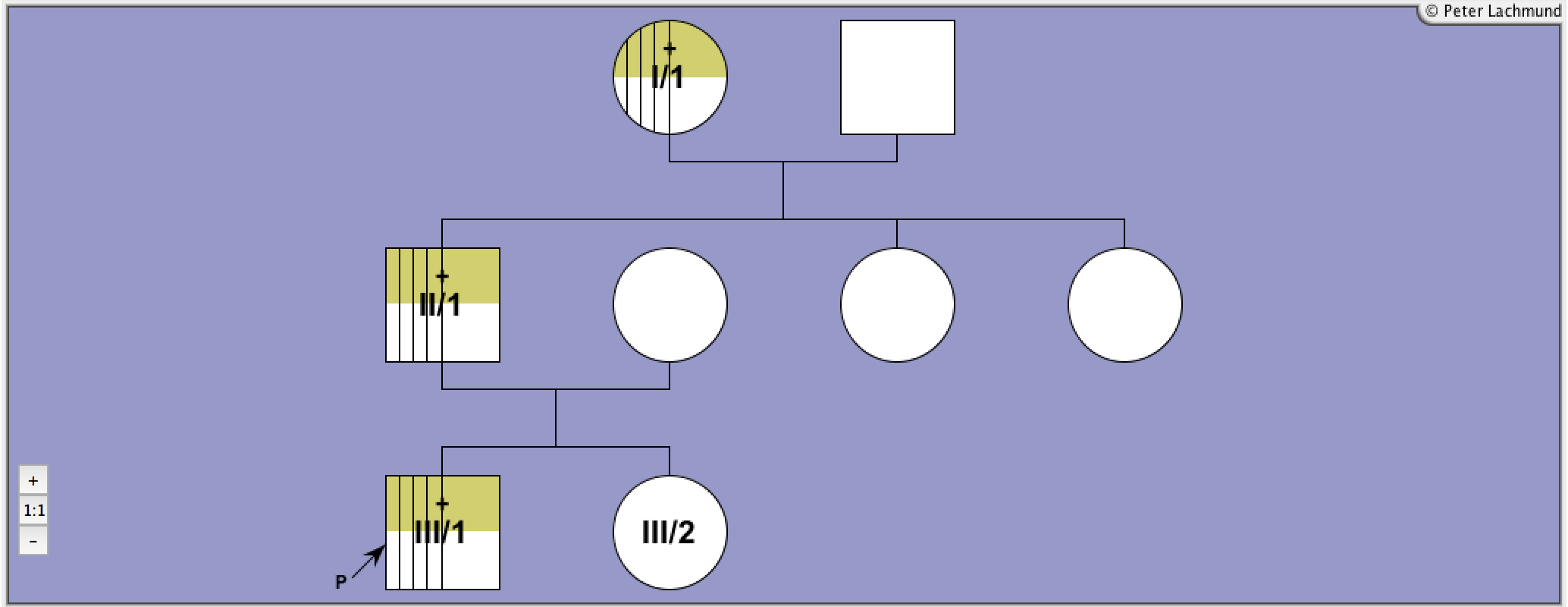Details Of Published TSH Receptor Mutation
Val 509 Ala
c.1526T>CConstitutively Activating TSH Receptor Mutation
Type
gain
Manifestation
family
Exon
10
Legend:

Male

Female

Unknown

Deceased
+
Mutation
-
No Mutation

Hyperthyroidism
(Heterozygous)
(Heterozygous)

Goiter

Relapse
P
Index Patient
Molecular Characteristics:
hereditary occurrence in 2 non-related families:
Family 1: "Nancy family" - Pedigree 1: Thomas et al.
first family described with activating TSHR germline mutation by Thomas et al., 1982
("Familial hyperthyroidism without evidence of autoimmunity")
transplantation of thyroid tissue from III-2 into nude mice: "autonomous behaviour"
Family 2 - Pedigree 2: Karges et al.
Family 1: "Nancy family" - Pedigree 1: Thomas et al.
first family described with activating TSHR germline mutation by Thomas et al., 1982
("Familial hyperthyroidism without evidence of autoimmunity")
transplantation of thyroid tissue from III-2 into nude mice: "autonomous behaviour"
Family 2 - Pedigree 2: Karges et al.
Clinical Features:
Family 1 "Nancy family" - Pedigree 1 (Thomas et al.):
diagnosis:
P1/I/1: 25yr
P1/II/3: 34yr
P1/II/6: 30yr
P1/II/7: 24yr
P1/III/9: 14yr
P1/III/15: 19yr
P1/III/18: 20yr
P1/III/20: 14yr
P1/III/22: 14yr
P1/III/23: 10yr
Family 2 - Family 2 (Karges et al.):
diagnosis:
P2/III/1: 4yr (index patient),goiter
P2/II/1: 18yr, goiter
P2/I/1: adulthood, goiter
* based on 2 activating familial germline mutations investigated by Thomas, Van Sande and Duprez and Karges et al. 2005
diagnosis:
P1/I/1: 25yr
P1/II/3: 34yr
P1/II/6: 30yr
P1/II/7: 24yr
P1/III/9: 14yr
P1/III/15: 19yr
P1/III/18: 20yr
P1/III/20: 14yr
P1/III/22: 14yr
P1/III/23: 10yr
Family 2 - Family 2 (Karges et al.):
diagnosis:
P2/III/1: 4yr (index patient),goiter
P2/II/1: 18yr, goiter
P2/I/1: adulthood, goiter
* based on 2 activating familial germline mutations investigated by Thomas, Van Sande and Duprez and Karges et al. 2005
Treatment:
Family 1 "Nancy family" - Pedigree 1(Thomas et al.):
P1/I/1: 4 x partial TE, radioiodine at 53yr
P1/II/3, P1/II/6: 1 x partial, 1 x total TE
P1/II/7, P1/III/9: partial TE, radioiodine treatment 12-20yr later
P1/III/15, P1/III/20, P1/III/23: 1 x partial TE, total or near-total TE 7-13yr later
Family 2 (Karges et al.):
P2/III/1: antithyroid drugs
P2/II/1: TE at 36yr, euthyroid with L-T4
P2/I/1: TE at 60yr, radio-iodine therapy
P1/I/1: 4 x partial TE, radioiodine at 53yr
P1/II/3, P1/II/6: 1 x partial, 1 x total TE
P1/II/7, P1/III/9: partial TE, radioiodine treatment 12-20yr later
P1/III/15, P1/III/20, P1/III/23: 1 x partial TE, total or near-total TE 7-13yr later
Family 2 (Karges et al.):
P2/III/1: antithyroid drugs
P2/II/1: TE at 36yr, euthyroid with L-T4
P2/I/1: TE at 60yr, radio-iodine therapy
Functional Characteristics:
cAMP
(basal)
(basal)
cAMP
(TSH)
(TSH)
IP
(basal)
(basal)
IP
(TSH)
(TSH)
TSH-Binding
Cell Surface Expression
Prevalence
LRA
Ref
3.0
n.d.
n.d.
n.d.
-
n.d.
2
2,3
Legend:
cAMP (basal): basal in vitro cAMP production of mutant over wild-type TSHR
cAMP (TSH): maximal in vitro cAMP production of mutant over wild-type TSHR
IP (basal): basal in vitro IP production of mutant over wild-type TSHR
IP (TSH): maximal in vitro IP production of mutant over wild-type TSHR
TSH-binding: maximal TSH-binding compared to the wild-type TSHR
Cell surface expression: cell surface expression of mutant compared to WT-TSHR
LRA: linear regression analysis (LRA) of constitutive activity as a function of TSHR expression determined by 125I-bTSH binding or FACS analysis compared to the wild-type TSHR
Prevalence: Prevalence of (somatic and germline) activating mutations*
Ref: Reference for functional characterization
Child: Found in children.
Reference 1:
Thomas et al.
Acta Endocrinologica 100: 512-518
Familial hyperthyroidism without evidence of autoimmunity
1982
Reference 2:
Duprez et al.
Nature Genetics 7: 396-401
Germline mutations in the thyrotropin receptor gene cause non-autoimmune autosomal dominant hyperthyroidism
1994
Reference 3:
Van Sande et al.
J. Clin. Endocrinol. Metab. 80: 2577-2585
Somatic and germline mutations of the TSH receptor gene in thyroid diseases
1995
Reference 4:
Karges et al.
J Endocrinol. 186: 377-85
TSH receptor mutation V509A causes familial hyperthyroidism by release of interhelical constraints between transmembrane helices TMH3 and TMH5.
2005


